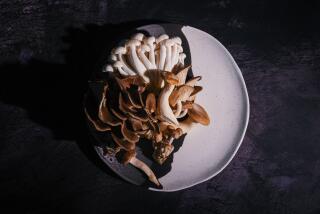Snails’ Pace Picks Up : Restaurants Snap Up Fresh Mollusks Grown Locally in a Budding Industry
- Share via
S-l-o-o-o-w-l-y but surely, Californians are beginning to raise, and eat, locally grown snails.
Fresh snails are turning up on Westside menus, and small-time snail farmers are turning up in such unlikely places as North Hollywood and San Pedro.
Chef Roland Gibert of Tulipe, who opened the Melrose Avenue restaurant in April with fellow chef Maurice Peguet, wouldn’t dream of using snails from a can--even one imported from France.
When Gibert prepares his ravioli of dried cured duck with California snails in a lovely green sauce, or parsley coulis, ($8 per appetizer serving), he uses only the liveliest gastropods, delivered, on the foot as it were, from a dealer in La Jolla, Calif.
Different Kind of Respect
Gibert buys 50-dozen live snails a week. With fresh snails, he explained, “I’m sure of what I’m getting.”
Chef Michael Roberts of Trumps on Melrose agrees that moving mollusks are superior to tinned ones. “From a chef’s point of view, it’s always better to start with something that’s alive than with something that comes in a can,” Roberts said. “You have a different kind of respect for food when you’ve started at the first step.”
Fresh snails have more “integrity” than canned ones, Roberts said, which is why he has served them as specials from time to time, either in red wine sauce with a whisper of garlic, or baked in a puffed pastry shell.
“They are adorable,” Roberts said of live snails. “They crawl around. You feed them. They become pets, and then you kill them.”
Most serious cooks and serious eaters prefer fresh snails, but preparing them for the table is no piece of cake. They must be purged of impurities before they can be safely cooked and eaten, a process that traditionally involves feeding them cornmeal or giving them only water for days or even weeks.
‘A Lot of Nasty Work’
Susan Feniger of City Restaurant on La Brea Avenue and the Border Grill on Melrose recalls that she and partner Mary Sue Milliken once shared their kitchen for several days with 10 buckets of California-grown snails. Eventually the women combined them with Serrano chilies, lime juice and cilantro to make snail salad for a restaurant-industry crowd. But as chef Gibert noted of the fresh snail: “From the live one to the plate, there’s a lot of nasty work to do.”
A growing number of back-yard snail farmers are willing to deal with the mundane unpleasantness of “snailiculture” in hopes of eventually making money on the mollusks. Like an earlier generation of worm farmers, they hope, naively or not, to spin a profit from a small initial investment and a lot of hard work nurturing unusual livestock.
Sandy Simmons, who has been eating back-yard snails since 1975, is gearing up to farm them commercially. She has about 12,000 head of the common garden variety-- Helix aspera-- in a homemade snailery on her property in North Hollywood. Simmons says her voracious stock eats all kinds of greens (something home gardeners already knew). They also like commercial catfish food, although they turn up their tentacles at hen food.
Simmons shields her snails from the sun so they won’t dry out. She devises ways to keep them well watered without allowing them to tumble in the water and drown. She tidies up after them, doing the snail farmer’s equivalent of mucking out the stable. And she keeps them out of her neighbor’s dahlias by edging their snailery with copper.
“When the copper hits their slime, it gives them a slight shock, and they usually won’t crawl over it,” she said.
Source of Protein
According to Simmons, snails were the first C rations. The Roman army found the live gastropods a convenient food to carry into war. They are a superior, low-calorie source of protein, says Simmons, who also believes snail slime has curative properties.
Simmons can’t imagine why more Americans don’t harvest the bounty slowly traversing their own back yards, as Europeans have done for centuries. “How better to rid your garden of the little creatures than to eat them?” asked Simmons, who likes hers dusted with a little seasoned flour and fried.
Like hundreds of others, Simmons has been encouraged in her dream of better living through snail farming by Ralph Tucker, 72, a retired insurance salesman who lives in Fresno.
Tucker is the nation’s leading booster of the home-grown or boutique snail, founder and president of the Snail Club of America, which has 750 members in the United States and 300 in other countries. According to Tucker, half the members of the club have commercial aspirations.
Pro-Snail Views
Tucker, who calls himself the snail king, is not amused by the sniggers with which listeners sometimes greet his strong pro-snail views. “They are laughing,” he said, “at the greatest food God put on Earth.”
According to Tucker, the diner who downs a canned snail “might as well be eating paper.” Tucker has given seminars in which he advises prospective farmers to start out with a half whiskey barrel, filled with moist dirt, snails and some lettuce to munch on, topped with a piece of “screen-door screen.” For safety’s sake, he warns converts never to eat a wild snail whose diet they haven’t personally supervised for at least 30 days. “If a snail is alive at the end of a month, you know that’s a healthy snail,” he counsels.
Tucker’s next project will be a videotape for cooks on what to do with them besides drowning them in garlic butter. His own uses for the gastropod, which he supplies to several restaurants in the Fresno area, include snail calzone (which he calls the Tucker Turnover) and snail jerky.
$300 Million in Imports
Tucker believes there is a largely untapped market among “the upper crust” (the name of his newsletter) for domestic snails. Tucker says the United States imports $300 million worth of inferior snails from France, Taiwan and elsewhere each year. He believes Americans could take over the snail market and that their product--good domestic snails for the gourmet palate--might command as much as $100 a pound. (Canned snails imported from France are selling for $10 a pound in some local supermarkets.) Tucker also believes they could be dried and turned into a protein-rich, powdered food for the world’s poor and hungry (possible slogan: “Let them eat escargots!”).
Currently, Tucker said, he has about 4,000 snails in a wooden back yard “oasis.” As they fatten for market, Tucker serenades them with classical and easy-listening music. “Right now their favorite song is ‘Wind Beneath My Wings,’ ” he said. “They also like Stevie Wonder’s ‘I Just Called to Say I Love You.’ But they don’t like Stevie. They like the instrumental version.”
In San Pedro, Giuseppe Cracchiolo has also hitched his wagon to a snail.
A 26-year-old native of Italy, Cracchiolo makes his living as a fisherman. As a sideline, he raises white snails-- Otala lactea-- which he says are far more tender than the common variety. Once people discover that succulent fresh snails are readily available, they’ll never go back to the rubbery canned kind, he said. “You wouldn’t want to eat a fish that was three or four days old,” he noted.
Although Cracchiolo sometimes keeps snails nearing market size (about an inch and a quarter) in plastic containers in his garage, the bulk of his herd is penned in a snailery on rural property owned by his uncle. There the feed bag is often filled with bread crumbs.
In Sicily, Cracchiolo’s mother stewed snails, still in their shells, with potatoes and tomatoes. He still likes them best that way.
Although the young entrepreneur sells his product to a retailer in the Fresno area for 35 cents each, Cracchiolo hasn’t been able to sell his wife, Geralynn, on snails.
“She’s American,” he explained. “She thinks they’re gross.”
More to Read
Eat your way across L.A.
Get our weekly Tasting Notes newsletter for reviews, news and more.
You may occasionally receive promotional content from the Los Angeles Times.








